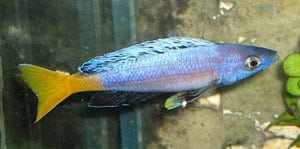
Common name: Sardine Cichlid, Slender Cichlid, Cyprichromis, Slender Cyprichromis
Scientific name: Cyprichromis Leptosoma, Limnochromis Leptosoma, Paratilapia Leptosoma
Average Adult Fish Size: 12cm / 4.5 Inches
Place of Origin: Lake Tanganyika
Typical Tank setup: Typical Tanganyika tank set up with plenty of open swimming space
Recommended Minimum Aquarium Capacity: 240 Litres
Compatibility: Other African Cichlids from Lake Tanganyika
Temperature: 23-28 Deg C / 73-82 Deg F
Water chemistry: pH 7.6-8.6
Feeding: Live; flying insects, insect larvae, aquatic insects, crustaceans; flakes; pellets. Be sure to give this fish a balanced diet including nutritious live foods.
Sexing: Cyprichromis are nearly impossible to sex until they begin to colour up, at which point it’s difficult to miss. Males develop over a period of a few months striking colours; generally the normal-sized varieties are bright colours, primarily blue and yellow, while Jumbo varieties are pastels, lavender and yellow, often with black. Females stay relatively drab. Males may begin to “shake” and shimmy occasionally before the first hints of colour appear, usually around an inch long.
Breeding: Although a pair or trio can be induced to breed, the basic spawning act of Cyprichromis is a huge group effort. In the wild, thousands of fish may be involved, and eggs from one female are often snapped up by another. In the tank or in the wild, the group hovers, heads down, shivering, as the females release eggs to be milted and then grab them up again. The eggs are quite large so broods are small; the small mouths of the females can only hold a handful, although the buccal cavity stretches quite a bit.
Additional Information: Cyprichromis need a tank large enough to allow schooling; 4′ is a good minimum length. The Jumbo varieties, which pass 6″ and may be given a separate species designation, need additional space. Cyps make the perfect addition to the unused water space in many Tanganyikan tanks, because they school above the rocks. Large schools of eight or more fish are necessary. Cyprichromis are, though somewhat delicate, usually off the radar of all but the most aggressive fish because they stay near the top of the tank. Although Cyprichromis, unlike the related Paracyprichromis, prefer open water to sheer rock faces, they nonetheless appreciate the security of tall plants or rock piles to dart into if need be. These available hiding spots will keep the Cyprichromis out in the open, helping convince their tank mates that the water’s fine and it’s safe to come out.


Related Posts
Croaking Gourami – Trichopsis vittatus
Benthochromis Tricoti
Large-eyed Mouthbrooder – Callochromis Macrops